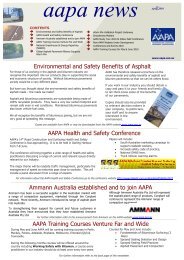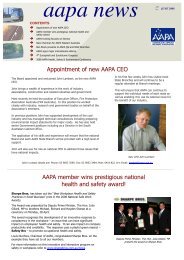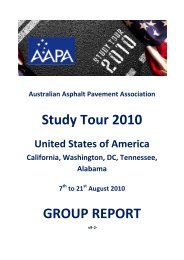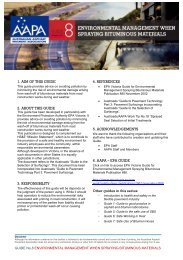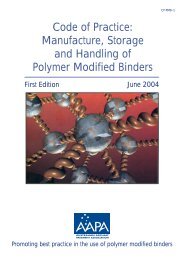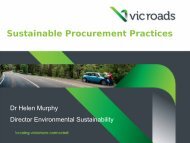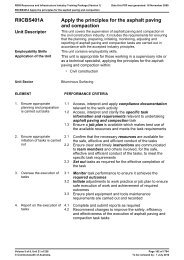Asphalt Review - Volume 29 Number 2 (June / July 2010)
Asphalt Review - Volume 29 Number 2 (June / July 2010)
Asphalt Review - Volume 29 Number 2 (June / July 2010)
You also want an ePaper? Increase the reach of your titles
YUMPU automatically turns print PDFs into web optimized ePapers that Google loves.
ASPHALT REVIEW<br />
...continued from previous page<br />
• mix design method;<br />
• design void content;<br />
• test results for design (laboratory mix);<br />
• test results for production mix;<br />
• field trial details; and<br />
• performance monitoring.<br />
Data Exchange<br />
Validation Projects should be undertaken jointly by industry and<br />
the road authorities. Any reports produced should therefore be<br />
provided to all participants for review. This will ensure that they<br />
are accurate and, where appropriate, do not divulge details of any<br />
proprietary products.<br />
The reports provided may then be used by road authorities, in<br />
consultation with industry, as a basis for consistent and appropriate<br />
specifications.<br />
Warm-mix asphalt position<br />
statement by GAPA<br />
The Global <strong>Asphalt</strong> Pavement Alliance (GAPA) is comprised<br />
of multi-national and national asphalt pavement associations<br />
throughout the world. We recognise the asphalt industry as<br />
the ultimate steward of our own product in terms of quality,<br />
performance, safety, and environmental benefit.<br />
In an effort to improve its already excellent environmental<br />
performance record, the GAPA supports the development and<br />
implementation of warm-mix asphalt.<br />
Warm-mix asphalt is the term used to describe a class of<br />
technologies employed to reduce the production and paving<br />
temperature of asphalt mixtures by 10 to 40 degrees centigrade.<br />
This temperature reduction may be effected through the use<br />
of mineral or organic additives or by mechanical means to<br />
introduce foaming into the production of asphalt mixtures.<br />
Warm-mix asphalt has been recognised as an environmentally<br />
friendly method to produce asphalt mixtures with the following<br />
benefits:<br />
• Higher product quality through better consistency and<br />
improved compaction;<br />
• Sustainability through reduced energy consumption and<br />
better performance;<br />
• Improved air quality through reduced emissions;<br />
• Reduced climate impact through reduced greenhouse gas<br />
generation;<br />
• Economic advantage through an extended paving season<br />
and longer haul distances;<br />
• Improved working conditions through the reduction of<br />
fumes and the reduction of temperature.<br />
The effectiveness of this green technology has been proven<br />
through ongoing implementation in Europe and the United<br />
States. This will inevitably become the standard practice for<br />
asphalt mixture production. We encourage others within the<br />
industry as well as our agency partners in all countries to<br />
become informed about warm-mix asphalt technology and to<br />
begin a path toward its implementation.<br />
Australian <strong>Asphalt</strong> Pavement Association<br />
European <strong>Asphalt</strong> Pavement Association<br />
Japan Road Contractors Association<br />
National <strong>Asphalt</strong> Pavement Association, USA<br />
Southern African Bitumen Association<br />
GAPA widens<br />
membership<br />
two years after<br />
formation<br />
At this time two years ago, the Global <strong>Asphalt</strong> Pavement<br />
Alliance (GAPA) came into being. The agreement to<br />
establish the alliance was signed in Copenhagen on 21<br />
May 2008 and reported in the <strong>June</strong>-<strong>July</strong> issue of Roads.<br />
The signatories to the alliance were:<br />
Australian <strong>Asphalt</strong> Pavement Association (AAPA);<br />
European <strong>Asphalt</strong> Pavement Association (EAPA);<br />
Japanese Road Contractors Association (JASA);<br />
(US) National <strong>Asphalt</strong> Pavement Association (NAPA)<br />
Southern African Bitumen Association (SABITA).<br />
The purpose of the Alliance was to build on existing<br />
links between the world asphalt associations to exchange<br />
information relevant to our industries. It recognised<br />
that there are many current and emerging issues such<br />
as sustainability and new technologies associated with<br />
pavement designs and materials. Most of these are<br />
relevant across the world and sharing information will be<br />
of benefit to all GAPA members.<br />
Under GAPA, the pavement associations can also<br />
provide consistent information to road authorities and<br />
the world community. This lead to a statement from the<br />
GAPA meeting held in January <strong>2010</strong> highlighting the<br />
importance of warm mix asphalt.<br />
In recent times, a lot of the information from research<br />
being undertaken in the US has been provided to AAPA and<br />
the other members. Information from Europe has also<br />
been provided, including on the use of asphalt in railway<br />
tracks that is highlighted in this edition of Roads.<br />
Recognising the benefits of the global alliance, two<br />
more asphalt associations have recently joined GAPA.<br />
They are Roading New Zealand and the Mexican <strong>Asphalt</strong><br />
Association [Asociación Mexicana del Asfalto, A.C. -<br />
(AMAAC)]. Other Associations are expected to join over<br />
the next few months.<br />
Currently Mike Acott, President of NAPA is the Executive<br />
Officer of GAPA.<br />
24 ROADS JUNE <strong>2010</strong>/JULY <strong>2010</strong>



